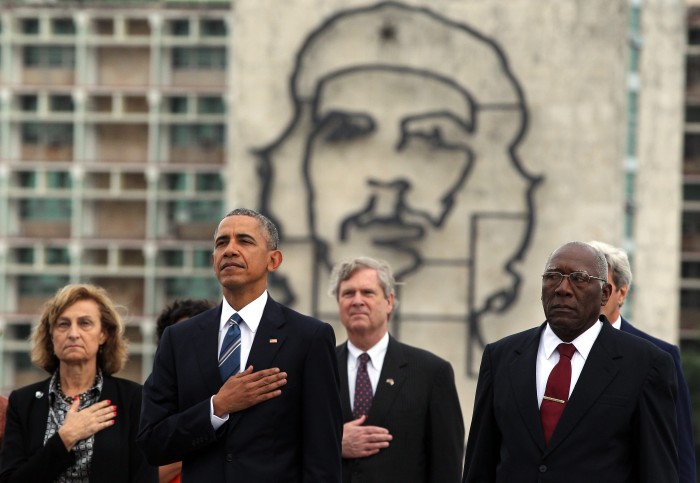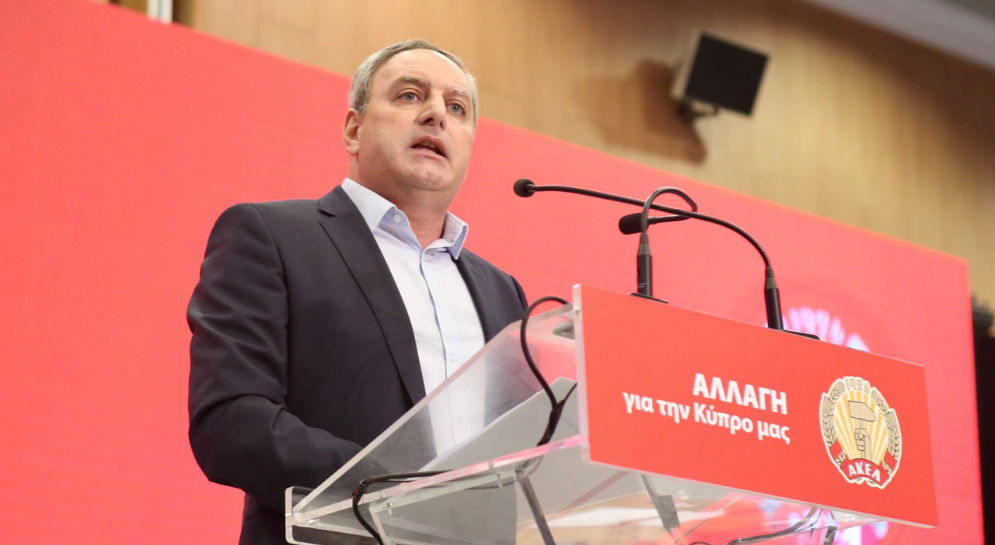
Obama’s Visit to Cuba – A change in tactics, the goal is the same
Article by Giorgos Koukoumas, Member of the International and European Affairs Department and of the C.C. of AKEL
“HARAVGI” daily newspaper, Sunday 27th March 2016
 The image of US President Obama in Revolution Square in Havana, Cuba with Che Guevara in the background embodies on a symbolic level, the new chapter in the US’s relations with the Island of the Revolution. The visit of the first American President to Cuba after 88 years offered the opportunity for front page newspaper headlines like “Obama tearing down walls.” Of course, for those who do not succumb to the American President’s communicative allure, the truth is somewhat different.
The image of US President Obama in Revolution Square in Havana, Cuba with Che Guevara in the background embodies on a symbolic level, the new chapter in the US’s relations with the Island of the Revolution. The visit of the first American President to Cuba after 88 years offered the opportunity for front page newspaper headlines like “Obama tearing down walls.” Of course, for those who do not succumb to the American President’s communicative allure, the truth is somewhat different.
First, the presentation of developments as some “happy end” between two eternal enemies who have both watered down their policies does not correspond to reality. The two sides weren’t both aggressive. It was the US side that never accepted that Cuba is not its “own backyard” and that the Cuban people have the right to choose its own leadership and the country’s path of socio-economic development. Relations between the two countries had stopped completely with the overthrow the Batista dictatorship, a US puppet, and the Victory of the Cuban Revolution in 1959. Cuba, 90 km from the American shores, not only would no longer be a pro-American protectorate where American monopolies would prevail, but instead socialist construction began and its leadership became an international revolutionary symbol.
Decades of bloody American aggression
The US under the Kennedy administration replied back then by launching the failed Bay of Pigs Invasion to overthrow the Castro government and subsequently immediately imposed a complete blockade of Cuba, which in fact is still ongoing to this today. The “Cold War” crisis of the Soviet missiles (October 1962) between the USSR and the US was required to intermediate for the US to declare that they will not attack Cuba again. In the years that followed, the remnants of the Batista dictatorship gathered in Florida, which became a centre of anti-communist and anti-Cuban activity.
For decades, the Cuban Miami mafia and the CIA were cooperating in waging attacks on hotels and Embassies of Cuba, in the shooting down of the Cuban aircraft in 1976, in waging biological warfare with the spreading of germs, in sabotage campaigns and – of course – in making several hundred attempts to assassinate Fidel. More recently, the US has been focusing on fermenting internal instability in order to construct a “multi-colour revolution” and a…”Havana Spring” for the overthrow of the Cuban government.
One of the recent attempts, according to the revelation made by the Associated Press in 2012, was the creation by the United States Agency for International Development (USAID) of a Cuban “twitter”, namely ZunZuneo, that would have networked into Cuban youth and provoke “spontaneous” anti-government meetings. However, the CIA’s inventiveness has not brought the desired results. Confronting even this US policy, however, Cuba has never refused a dialogue, setting the mutual respect for the sovereignty of each country as its sole condition.
Change in tactics, not in the goal
Throughout all these years the Cuban people not only did not abandon its leadership, but showed remarkable levels of endurance, unity and heroism. Cuba’s achievements – in the conditions of a blockade – in education, health and medicine, sports, internationalist medical and educational assistance programs around the world was the Cuban people’s response to the fierce attacks it came under for decades. Coupled with the continued international pressure exerted for the lifting of the blockade and the changing moods in American public opinion, the US was forced to change tactics, but not the goal.
When Obama says that “the strict American policy towards Cuba did not work”, “it wasn’t in our interest” and “it wounded the Cuban people,” he means that he failed to turn Cubans against their leadership and the socialist system. It is characteristic that the American President not only talks about a change in US-Cuba relations, but also about “change in Cuba” which the US continues to pursue and which will be promoted by other means.
The blockade and Guantánamo, big thorns
Obama’s visit is a continuation of the normalization process in Cuban-US relations which started in December 2014 with the opening of embassies, direct air and postal connections, cooperation in health, agriculture, education and the easing of restrictions on American investment in Cuba. However, there are still two major thorns about which Obama makes only verbal declarations.
The US refuses to abolish the economic, commercial and financial blockade of Cuba, which has cost more than $ 1 trillion to the Cuban economy with literally deadly consequences for the people who is deprived of access to medicines, medical supplies and logistics. The fact that Obama promises that Congress will at some point be persuaded that “the blockade will end, but I cannot be sure when …” does not negate the US contempt for the UN General Assembly which has for 24 consecutive years with an overwhelming majority been calling for the end of the blockade. It is characteristic that last October, only two states in the world voted for the continuation of the blockade: the US and Israel…
The second thorn is the military prison at the US naval base of Guantanamo on the territory of Cuba. Since 2002, the US is transferring “terror suspects” to Guantanamo – some without being accused of anything – where all that is provided for under International and US law with regards conditions of detention, the holding of a trial and so forth are not applied. Guantanamo is essentially a black hole in the legal system of the planet which has evolved into a hellhole of torture. The appeals issued by the United Nations for the closure of Guantanamo have only resulted in promises being made by Obama; promises awaiting their fulfilment. Cuba, however, points out that the 120 square kilometres of Cuban territory the United States are keeping under their control must be returned to Cuba and its people.
Democracy and rights
The truth is that neither Obama, nor Raul Castro hid the fact that, despite the current approach, they continue to have major differences on how the two countries perceive the economy, human rights and the world. The US president has used his presence in Cuba to advertise the “advantages” of an open economy and “American freedom” in general which will be promoted when Cubans abandon socialism. However, the charm operation will not be so easy because now there is the experience of Eastern Europe where the fall of the Berlin Wall highlighted the false promises about a world of freedom and prosperity.
The US president also reiterated – discreetly though – American accusations about human rights and democracy in Cuba. Besides, you would not expect Obama to talk about the human rights of the peoples of Iraq or Afghanistan. Neither about the human rights of those who suffered in the secret CIA prison network (whose torturers he himself protected) or about the filing of citizens by the global NSA surveillance network. Before giving lessons to others, Obama should have studied the reports of UN bodies on the state of human rights in the US which are not at all favourable.
Raul Castro in turn made a fundamental point: Human rights – individual, social, economic – are indivisible, adding, in a clear reference to the hypocrisy of the capitalist system, that “we do not just defend human rights, but we consider it unthinkable for a government not to be able to ensure the right to health, education, social security, nutrition, development, equal pay and children’s rights.”
Socialism is non-negotiable
Many associate the current Cuba-US approach with the “updating of the economic and social policy” of Cuba that was decided by the 6th Congress of the Communist Party of Cuba in April 2011, with which the socialized sector of the economy was restricted, self-employment was strengthened and the margin for foreign investment was broadened.
Indeed, sections of US capital – especially those associated with the Democrats – are celebrating in the belief that Cuba is on the road of “capitalization” and are calling for the need to “seize” the opportunities. For them the anti-Cuban hysteria of the Republicans is considered outdated, not because they disagree on the essence, but because it is considered ineffective. On the other side there are concerns about the future of socialist construction, pointing to the example of the Chinese economy and many see a Trojan horse in the communication steamroller called Obama. However, the Communist Party of Cuba affirms in every direction that this opening up is aiming to tackle the real problems and that the economy’s socialist character is non-negotiable.
Solidarity must be strengthened
The only certainty is that the Cuban people, who believe in its historical choice, have to be vigilant and constantly deepen socialism and its advantages. Those in the world who are inspired not just by the exotic beauty of Cuba and the Cuban temperament, but also by the Revolution and the victories of a heroic people who held banners high against the winds of the new world order, have today – more than ever before – a duty to strengthen their solidarity.




